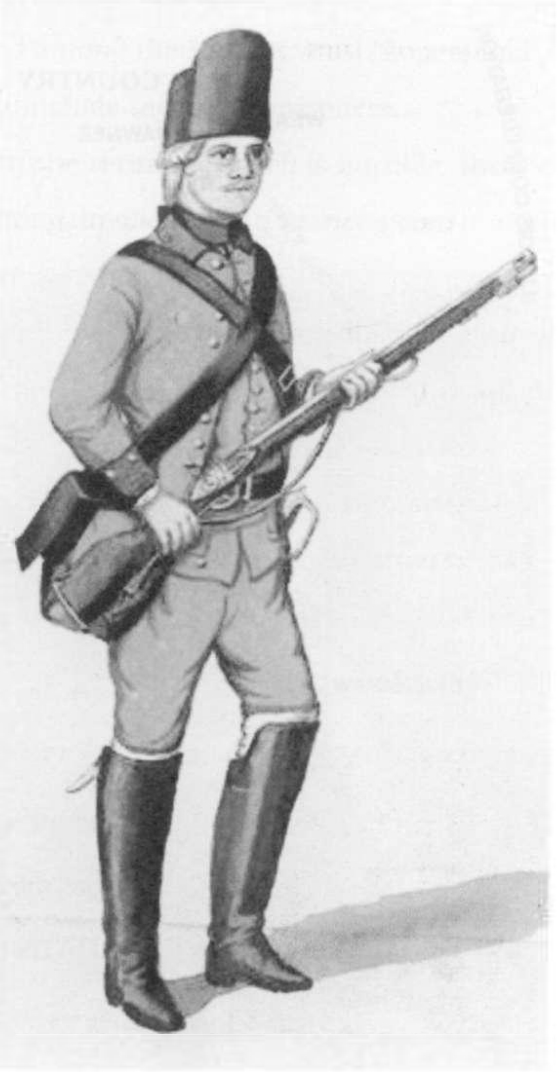
An Austrian Jäger (Hunter) rifleman.
Norwegian ski troops stabilize rifles on ski poles, approximately 1700.
Despite their limited usefulness, rifles still occasionally managed to find their way into battle-and some of history’s most lucrative targets were among their first.
Rifles were not adopted for general military issue, and with good reason: rifle-armed infantrymen would have been at a tremendous disadvantage. Reloading a snug-fitting rifled bore was a tedious process, taking about two minutes. At such a slow rate of fire, given the rifle’s typical range-perhaps 200 yards-a line of riflemen would have been bombarded by 25 volleys of smoothbore musket fire and a bayonet assault before they could load for a second shot. And the cost! A rifle required extensive hand finishing, costing three to four times the price of a smoothbore. Further, there was no means to attach a bayonet, and just as well-most rifles, especially long-barreled American guns, were too slender and delicate for bayonet fighting.
It was obvious to military leaders of the day that victories were determined not by shot placement but by reloading quickly and maintaining well-drilled discipline under fire. Of what possible military value was selective, accurate fire? What difference did it make which opposing infantryman a rifleman selected to engage? There were masses of fast-firing muskets to do that, rapidly shooting, reloading, and shooting. Volley fire from rows of well-drilled infantrymen firing smoothbore muskets-that’s what w o n battles, according to 18th-century European generals. It seemed the height of folly to jeopardize this winning equation and instead rely on the agonizingly slow fire of riflemen.
At the naval Battle of Texel on 10 August 1653, Admiral Martin Harpertszoon Tromp, the commander of the 100-ship Dutch fleet and the victor of a dozen engagements with the British, stood at the helm of his flagship, the Brederode, as she neared the enemy’s flagship. Colorfully attired and in conspicuous command, Tromp offered too grand a target for a British rifleman perched high in the nearby ship’s rigging. That sharpshooter’s well-placed shot not only struck down Holland’s foremost naval leader, but also contributed mightily to the Dutch loss at Texel and, with that, a British victory in the First Anglo-Dutch War. Equally, though, Tromp’s death ended any hope of restoring England’s pro-Dutch Stuart monarchy. In grateful recognition, Britain’s King Charles II presented his victorious admiral a New World land grant that the admiral’s son, William Penn, would use to found Pennsylvania-quite a dramatic chain of events from one well-aimed shot.
In 1709, no less momentous were the results of another sharpshooter’s skills. Sweden’s King Charles XII, a youthful, Alexander-like warrior-monarch, inspired his tiny army to dominate the Baltic region. After defeating Denmark, he invaded Poland, seized Saxony, and even fought Czar Peter the Great’s Russia. Brave to the point of recklessness, King Charles did not attempt to conceal his presence while inspecting his front line before one of history’s pivotal battles at Poltava in the Ukraine. He proved an irresistible target for a distant Russian sharpshooter, who took careful aim and nearly missed, striking his majesty in the left foot. The king’s wound festered. Though feverish, 11 days later Charles attempted to command from a stretcher, but the czar’s troops decisively defeated the demoralized Swedes.
Though he retained the throne in Stockholm, this was not the last meeting this monarch would have with a rifleman. Nine years later, on 30 November 1718, while besieging the Norwegian fortress of Fredriksball, King Charles XII raised his head above a wall to observe the action when “a well-aimed shot” struck his left temple, killing him instantly. Thus one Norwegian rifleman ended forever Sweden’s dominance of northern Europe. (And reminiscent of John F. Kennedy conspiracy claims 250 years later, rumors flew that the king had actually been assassinated by Swedish political enemies. Twice, in 1746 an d 1859, his body was exhumed, only to determine that “the fatal shot had been fired from a distance on the king’s left, and from a higher level than that on which he stood.”)
The rifle that killed King Charles XII may well have been a German Model 1711, an early European military rifle manufactured by gunmaker Zella Mehlis, available both in full-length and carbine versions, the latter with a 22-inch barrel. It was known to have been used in the Great Northern War of 1700-1721. Later the Model 1711 was issued to Norway’s sonnenfjellske ski troops, one of Europe’s earliest sharpshooter units.
Where did these early sharpshooters come from? Prior to the 1750s, incidents of military sharpshooting were extremely rare because rifles were extremely rare. Few armies possessed rifles, and there were no military courses to instruct any kind of basic marksmanship, much less precision shooting. To find such expert shooters, armies had to look outside their own ranks, calling on self-taught marksmen already skilled with rifles. It could be said that every 18th-century rifleman, w h e n thus called into military service, was a sharpshooter since only a rifleman could selectively engage targets or hit targets beyond the range of the common infantryman.
Austria and Prussia, too, fielded sharpshooters armed with hunter rifles (Jägerstutzen). In 1744, Prussia organized a special corps of “Field Hunters on Foot” (Feldjäger zu Fufs), recruited from professional Alpine hunters and noted marksmen, outfitted with long-barreled rifles and employed as light infantry. These Feldjägers preceded conventional infantry formations as scouts and skirmishers, remaining close enough for concerted action with the main body, which also could protect them with massive firepower. The following year, Austria established a similar light infantry unit, called the Hunter Group (Jägertruppe), manned by professional hunters from Alpine regions.